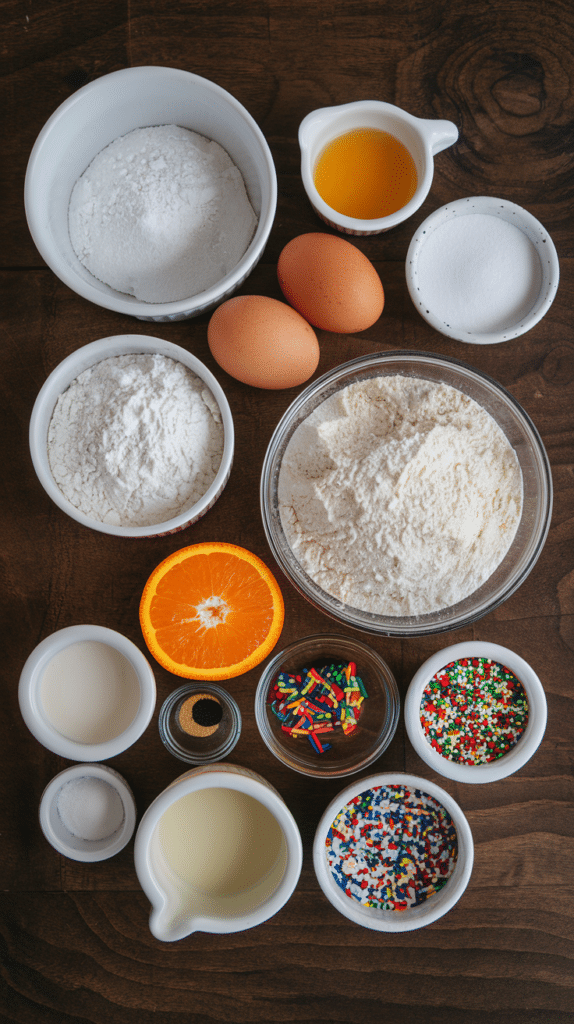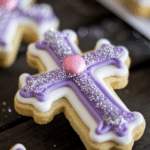Introduction & Inspiration
Making decorated Easter cookies is more than just baking; it’s a tradition, a creative outlet, and a way to celebrate the season. This article is your ultimate guide to creating beautiful and delicious Easter cookies, starting with a classic sugar cookie base and a simple buttercream frosting. While the recipe provided forms the core of our baking project, we’ll explore every aspect, from ingredient selection to advanced decorating techniques, ensuring your Easter cookies are truly egg-cellent!
My personal inspiration for diving deep into Easter cookies comes from years of family baking traditions. Every spring, the kitchen would transform into a flurry of flour, frosting, and sprinkles. It wasn’t just about the cookies themselves; it was about the shared experience, the creativity, and the joy of making something special together.
I also want to empower you, the reader, to feel confident in your cookie-making abilities. Whether you’re a seasoned baker or a complete beginner, this guide will provide you with the knowledge and inspiration you need to create Easter cookies that are both beautiful and delicious.
We will explore alternative ingredients, different baking methods.
Nostalgic Appeal
Easter cookies tap into a rich vein of nostalgia. For many, they conjure images of childhood, with brightly colored eggs, baskets overflowing with treats, and the sweet scent of baking wafting through the house. They’re a tangible link to springtime celebrations and cherished family traditions.
The act of making cookies itself – rolling out dough, cutting out shapes, and decorating with colorful frosting and sprinkles – is a sensory experience that can transport us back to simpler times. It’s a chance to reconnect with those feelings of joy, creativity, and anticipation.
Beyond personal memories, Easter cookies also connect us to broader cultural traditions. Cookies, in various forms, have been part of springtime celebrations for centuries, symbolizing renewal, rebirth, and the sweetness of life. They are perfect for sharing.
Even the simplest sugar cookie, when decorated with a touch of pastel frosting and a few sprinkles, can become a powerful symbol of the season and the joy of shared moments. It’s about more than just the taste; it’s about the memories and emotions they evoke.
Homemade Focus
In a world of store-bought convenience, there’s something truly special about creating something from scratch. This guide emphasizes the homemade aspect of Easter cookies, from the buttery dough to the creamy frosting. While we’ll discuss some shortcuts, the heart of this project is about the joy of baking.
Making your own cookie dough and frosting allows you to control the quality of the ingredients. You can choose real butter, pure vanilla extract, and high-quality flour, knowing that these choices will directly impact the flavor and texture of your finished cookies.
The process of baking is also inherently rewarding. The aroma that fills your kitchen as the cookies bake, the anticipation of seeing them come out of the oven, and the satisfaction of decorating them with your own unique designs – these are all part of the homemade experience.
It is a great activity to do with childrens.
Flavor Goal
The flavor goal for these Easter cookies is a delicate balance of buttery sweetness, a hint of citrus from the orange zest, and the creamy richness of the buttercream frosting. We’re aiming for a classic sugar cookie taste that’s enhanced by the decorations.
The cookie itself should be tender, yet slightly crisp around the edges. It should be sweet, but not overwhelmingly so, allowing the flavors of the orange zest and vanilla to shine through.
The buttercream frosting should be light, fluffy, and intensely buttery, with a smooth, creamy texture. The heavy cream contributes to its luxuriousness.
The decorations – sanding sugar, sprinkles, and other embellishments – add not only visual appeal but also textural contrast and pops of sweetness. The overall experience should be a delightful combination of flavors and textures.
Ingredient Insights
Let’s break down the key ingredients and explore why they’re important, along with potential substitutions and considerations:
For the Cookies:
- Shortening or Softened Butter: The recipe offers a choice. Shortening creates a softer, more cake-like cookie with less spread. Butter provides a richer, more flavorful cookie with slightly crisper edges. The choice depends on your preference.
- Sugar: Granulated sugar provides sweetness and contributes to the cookie’s texture.
- Orange Zest: This adds a bright, citrusy note that elevates the flavor of the cookie. Lemon zest or even a combination of citrus zests would also work.
- Eggs: Eggs bind the ingredients together and add richness and moisture. Make sure they’re at room temperature for better emulsification.
- Vanilla Extract: A classic flavoring for sugar cookies. Pure vanilla extract is always recommended for the best flavor.
- All-Purpose Flour: Provides the structure for the cookies. Be sure to measure flour correctly (spoon and level method, or ideally, by weight) to avoid adding too much, which can result in dry, tough cookies.
- Baking Powder: The leavening agent that helps the cookies rise and become slightly puffy. Make sure your baking powder is fresh for optimal results.
- Salt: Balances the sweetness and enhances the other flavors. Fine sea salt is recommended for its clean flavor.
- Whole Milk: Adds moisture to the dough.
For the Frosting:
- Salted Butter, Softened: Provides the base of the buttercream, adding richness and flavor. Using salted butter helps to balance the sweetness of the powdered sugar.
- Powdered Sugar: Provides sweetness and structure to the frosting. Sifting the powdered sugar before adding it to the butter will help to prevent lumps.
- Heavy Cream: Adds creaminess and helps to create a light and fluffy texture.
- Food Coloring (optional): For tinting the frosting in various Easter colors. Gel food coloring is recommended for the most vibrant color without adding excess liquid.
For Decorating:
- Sanding Sugar: Adds sparkle and a slightly crunchy texture.
- Sprinkles: Add color and fun. Choose a variety of shapes and colors for Easter.
- Other Decorations: Get creative! You can use edible glitter, small candies, or even edible flowers to decorate your cookies.
Essential Equipment
Having the right tools makes the cookie-making process much easier and more enjoyable. Here’s a list of essential equipment:
- Electric Mixer (Stand Mixer or Hand Mixer): Essential for creaming the butter and sugar, and for making the frosting. A stand mixer is more convenient, but a hand mixer works perfectly well.
- Large Mixing Bowls: You’ll need at least two: one for the wet ingredients and one for the dry ingredients.
- Measuring Cups and Spoons: Accurate measurements are crucial for baking success.
- Baking Sheets: For baking the cookies.
- Baking Mat or Parchment Paper: Lining the baking sheets prevents the cookies from sticking and makes cleanup easier.
- Rolling Pin: For rolling out the cookie dough.
- Cookie Cutters: Choose a variety of Easter-themed shapes, such as bunnies, eggs, chicks, flowers, etc.
- Wire Rack: For cooling the cookies completely after baking.
- Small Bowls: For holding different colors of frosting and decorations.
- Dinner Knife or Offset Spatula: For spreading the frosting on the cookies.
- Piping Bags and Tips (Optional): For creating more intricate frosting designs.
- Sifter: to sift the dry ingredients
- Zester/Grater: To zest the orange.
List of Ingredients with Measurements
Here’s the recipe with precise measurements:
For the Cookies:
- 1 1/3 cups shortening or softened unsalted butter
- 1 1/2 cups granulated sugar
- Zest of 1 orange
- 2 large eggs
- 1 teaspoon vanilla extract
- 4 cups all-purpose flour
- 3 teaspoons baking powder
- 1/2 teaspoon fine sea salt
- 2 tablespoons whole milk + 2 teaspoons whole milk
For the Frosting:
- 1 cup salted butter, softened
- 4 cups powdered sugar
- 1/4 cup heavy cream
- Food coloring (optional)
- Assorted sprinkles and decorations

Step-by-Step Instructions
Let’s break down the process into manageable steps:
Part 1: Making the Cookie Dough
- Cream Butter, Sugar, and Zest: In the bowl of an electric mixer (stand mixer or hand mixer), add the shortening (or softened butter), sugar, and orange zest. Beat until the mixture is smooth and creamy. This step is crucial for incorporating air and creating a light texture.
- Add Eggs and Vanilla: Add the eggs one at a time, beating well after each addition. Scrape down the sides of the bowl as needed to ensure everything is well combined. Beat in the vanilla extract.
- Combine Dry Ingredients: In a separate large bowl, sift together the flour, baking powder, and salt. This ensures that the leavening agents are evenly distributed and removes any lumps from the flour.
- Alternate Adding Dry Ingredients and Milk: Gradually add the dry ingredients to the wet ingredients, alternating with the milk. Begin and end with the dry ingredients. Mix on low speed until just combined. Do not overmix, as this can develop the gluten in the flour and result in tough cookies.
- Chill the Dough: Divide the dough in half. Flatten each half into a disc shape. Place each disc in a separate plastic bag (or wrap tightly in plastic wrap). Chill the dough in the refrigerator for at least 2 hours, or preferably overnight. This chilling step is essential for preventing the cookies from spreading too much during baking and for making the dough easier to roll out.
Part 2: Baking the Cookies
- Preheat Oven and Prepare Baking Sheets: After the dough has chilled, preheat your oven to 375°F (190°C). Line baking sheets with baking mats or parchment paper.
- Roll Out Dough: On a lightly floured surface, roll out one disc of dough at a time to about 1/3 inch thickness. Keep the other disc of dough refrigerated while you work.
- Cut Out Cookies: Use your favorite Easter-themed cookie cutters to cut out shapes from the dough. Reroll the scraps of dough and continue cutting out cookies until all the dough is used.
- Place on Baking Sheets: Place the cut-out cookies on the prepared baking sheets, leaving a little space between them.
- Bake: Bake for 8 to 10 minutes, or until the cookies are just set and the edges are very lightly golden. You don’t want them to brown much, as this will make them too crisp.
- Cool: Remove the cookies from the oven and let them cool on the baking sheets for a few minutes before transferring them to a wire rack to cool completely. They must be completely cool before frosting.
Part 3: Making the Frosting
- Beat Butter: While the cookies are cooling, make the frosting. In a large bowl, using an electric mixer, beat the softened butter until very light and fluffy. This will take several minutes.
- Gradually Add Powdered Sugar: Gradually add the powdered sugar, beating on low speed until combined.
- Add Cream: Add the heavy cream and beat on high speed until the frosting is light, fluffy, and holds its shape.
- Divide and Color (Optional): If you want to use different colors of frosting, divide the frosting into smaller bowls and tint each portion with food coloring. Gel food coloring is recommended for the most vibrant colors without adding too much liquid.
Part 4: Decorating the Cookies
- Frost Cookies: Once the cookies are completely cool, use a dinner knife or an offset spatula to spread a layer of frosting on each cookie.
- Decorate: Decorate the frosted cookies with sanding sugar, sprinkles, and other decorations as desired. Get creative and have fun!
- Let Frosting Set (Optional): If you want the frosting to set more firmly, you can refrigerate the decorated cookies for 15-20 minutes.

Troubleshooting
Even experienced bakers encounter occasional hiccups. Here’s how to troubleshoot some common cookie-baking problems:
- Cookies Spread Too Much: This is the most common issue with sugar cookies. The primary cause is usually dough that is too warm. Make sure your dough is thoroughly chilled before rolling and cutting. Other potential causes include: too much butter, not enough flour, or an oven that’s not hot enough.
- Cookies are Dry and Crumbly: This could be due to overmixing the dough, using too much flour, or overbaking. Be sure to measure your flour correctly (spoon and level method, or by weight), mix the dough just until combined, and don’t overbake.
- Cookies are Tough: This is usually caused by overmixing the dough, which develops the gluten in the flour. Mix the dough just until the ingredients are combined.
- Frosting is Too Thin: Add more powdered sugar, a little at a time, until the frosting reaches the desired consistency.
- Frosting is Too Thick: Add a little more heavy cream, a teaspoon at a time, until the frosting is smooth and spreadable.
- Cookies are Unevenly Baked: Rotate the baking sheets halfway through the baking time. Also, make sure your oven temperature is accurate (use an oven thermometer).
Tips and Variations
Here are some tips for success and variations to try:
- Chilling the Dough is Crucial: Don’t skip the chilling step! It’s essential for preventing the cookies from spreading too much and for making the dough easier to work with.
- Use Room Temperature Ingredients (for the Frosting): Make sure your butter is softened to room temperature for the frosting. This will ensure a smooth and creamy consistency.
- Don’t Overbake: The cookies should be just set and very lightly golden around the edges. They will continue to firm up as they cool.
- Get Creative with Decorations: Use a variety of sprinkles, sanding sugars, edible glitter, candies, and even royal icing to create unique and festive Easter cookies.
- Flavor Variations:
- Lemon Cookies: Add lemon zest and a teaspoon of lemon extract to the dough.
- Chocolate Cookies: Add 1/2 cup of cocoa powder to the dry ingredients.
- Spice Cookies: Add 1 teaspoon of ground cinnamon, 1/2 teaspoon of ground ginger, and 1/4 teaspoon of ground cloves to the dry ingredients.
- Frosting Variations:
- Cream Cheese Frosting:
- Chocolate Frosting
Serving and Pairing Suggestions
These Easter Cookies are perfect for:
- Easter celebrations and egg hunts
- Springtime parties and gatherings
- School events and bake sales
- Afternoon tea
- A sweet treat any time of year!
Pairing Suggestions:
- A glass of cold milk
- Coffee or tea
- Hot chocolate
- A glass of sparkling wine or champagne (for the adults!)
Nutritional Information
These values are approximate, and may vary.
Here’s an approximate nutritional breakdown per cookie (assuming 24 cookies, with frosting):
- Calories: 200-250
- Fat: 10-15g
- Saturates: 6-8g
- Protein: 2-3g
- Carbohydrates: 25-30g
- Fiber: 0-1g
- Sugar: 15-20g
- Sodium: 100-150mg
These are cookies, so they are relatively high in sugar and fat. Enjoy them as a treat!
PrintEaster Cookies
Learn how to make perfect, delicious, and beautifully decorated Easter cookies! This comprehensive guide covers everything from choosing ingredients to advanced decorating techniques, troubleshooting, variations, and more.
Ingredients
Here’s the recipe with precise measurements:
For the Cookies:
- 1 1/3 cups shortening or softened unsalted butter
- 1 1/2 cups granulated sugar
- Zest of 1 orange
- 2 large eggs
- 1 teaspoon vanilla extract
- 4 cups all-purpose flour
- 3 teaspoons baking powder
- 1/2 teaspoon fine sea salt
- 2 tablespoons whole milk + 2 teaspoons whole milk
For the Frosting:
- 1 cup salted butter, softened
- 4 cups powdered sugar
- 1/4 cup heavy cream
- Food coloring (optional)
- Assorted sprinkles and decorations
Instructions
Let’s break down the process into manageable steps:
Part 1: Making the Cookie Dough
-
- Cream Butter, Sugar, and Zest: In the bowl of an electric mixer (stand mixer or hand mixer), add the shortening (or softened butter), sugar, and orange zest. Beat until the mixture is smooth and creamy. This step is crucial for incorporating air and creating a light texture.
-
- Add Eggs and Vanilla: Add the eggs one at a time, beating well after each addition. Scrape down the sides of the bowl as needed to ensure everything is well combined. Beat in the vanilla extract.
-
- Combine Dry Ingredients: In a separate large bowl, sift together the flour, baking powder, and salt. This ensures that the leavening agents are evenly distributed and removes any lumps from the flour.
-
- Alternate Adding Dry Ingredients and Milk: Gradually add the dry ingredients to the wet ingredients, alternating with the milk. Begin and end with the dry ingredients. Mix on low speed until just combined. Do not overmix, as this can develop the gluten in the flour and result in tough cookies.
-
- Chill the Dough: Divide the dough in half. Flatten each half into a disc shape. Place each disc in a separate plastic bag (or wrap tightly in plastic wrap). Chill the dough in the refrigerator for at least 2 hours, or preferably overnight. This chilling step is essential for preventing the cookies from spreading too much during baking and for making the dough easier to roll out.
Part 2: Baking the Cookies
-
- Preheat Oven and Prepare Baking Sheets: After the dough has chilled, preheat your oven to 375°F (190°C). Line baking sheets with baking mats or parchment paper.
-
- Roll Out Dough: On a lightly floured surface, roll out one disc of dough at a time to about 1/3 inch thickness. Keep the other disc of dough refrigerated while you work.
-
- Cut Out Cookies: Use your favorite Easter-themed cookie cutters to cut out shapes from the dough. Reroll the scraps of dough and continue cutting out cookies until all the dough is used.
-
- Place on Baking Sheets: Place the cut-out cookies on the prepared baking sheets, leaving a little space between them.
-
- Bake: Bake for 8 to 10 minutes, or until the cookies are just set and the edges are very lightly golden. You don’t want them to brown much, as this will make them too crisp.
-
- Cool: Remove the cookies from the oven and let them cool on the baking sheets for a few minutes before transferring them to a wire rack to cool completely. They must be completely cool before frosting.
Part 3: Making the Frosting
-
- Beat Butter: While the cookies are cooling, make the frosting. In a large bowl, using an electric mixer, beat the softened butter until very light and fluffy. This will take several minutes.
-
- Gradually Add Powdered Sugar: Gradually add the powdered sugar, beating on low speed until combined.
-
- Add Cream: Add the heavy cream and beat on high speed until the frosting is light, fluffy, and holds its shape.
-
- Divide and Color (Optional): If you want to use different colors of frosting, divide the frosting into smaller bowls and tint each portion with food coloring. Gel food coloring is recommended for the most vibrant colors without adding too much liquid.
Part 4: Decorating the Cookies
-
- Frost Cookies: Once the cookies are completely cool, use a dinner knife or an offset spatula to spread a layer of frosting on each cookie.
-
- Decorate: Decorate the frosted cookies with sanding sugar, sprinkles, and other decorations as desired. Get creative and have fun!
-
- Let Frosting Set (Optional): If you want the frosting to set more firmly, you can refrigerate the decorated cookies for 15-20 minutes.
Recipe Summary and Q&A
Let’s recap the recipe and answer some frequently asked questions:
Recipe Summary: We made Easter Cookies by creaming together shortening (or butter), sugar, and orange zest, adding eggs and vanilla, incorporating dry ingredients (flour, baking powder, salt) alternately with milk, chilling the dough, rolling it out, cutting out shapes, baking until set, and decorating with homemade buttercream frosting and various toppings.
Q&A:
Q: Can I use butter instead of shortening in the cookie dough?
A: Yes, you can use softened unsalted butter instead of shortening. Butter will give the cookies a richer flavor and a slightly crisper texture. If using butter, you may not need to chill the dough as long, or you may need to let it soften slightly at room temperature before rolling it out.
Q: Can I make the dough ahead of time?
A: Yes, you can make the dough up to 3 days in advance and store it in the refrigerator, tightly wrapped in plastic wrap. You can also freeze the dough for up to 2 months. Thaw it in the refrigerator overnight before rolling and cutting.
Q: Can I make the frosting ahead of time?
A: Yes, you can make the frosting up to 3 days in advance and store it in an airtight container in the refrigerator. Bring it to room temperature and re-whip it briefly before using.
Q: Can I freeze the baked cookies?
A: Yes, you can freeze the baked, unfrosted cookies. Let them cool completely, then place them in a freezer-safe bag or container. Freeze for up to 2 months. Thaw at room temperature before frosting and decorating.
Q: How do I store the decorated cookies?
A: Store the decorated cookies in

